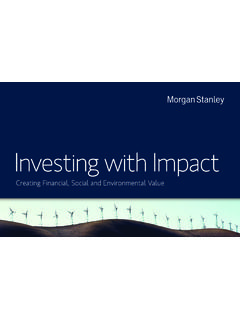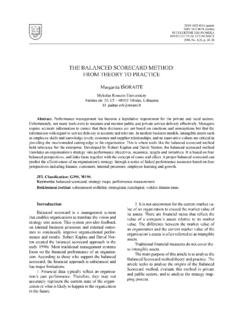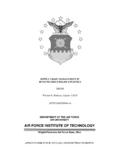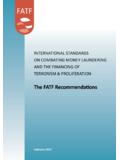Transcription of The Social Responsibility of Non-Profit Organisations
1 Pau Vidal / Domingo Torres B rbara Guix / Mar a Pe a Rodr guez The Social Responsibility of Non-Profit Organisations A conceptual Approach and Development of SRO model Authors : Pau Vidal Expert in management of Non-Profit Organisations . Degree in Business Administration and MBA from ESADE University. Lecturer at ESADE University on the subjects management of Non-Profit Organisations and project management, and joint manager of the postgraduate course Managerial Function of NGOD at ESADE University. Guest lecturer in strategic planning at the UCA (University of El Salvador) and on the Master of Cooperation at ETEA (Seville). He has collaborated on training and consultancy projects in the Non-Profit sector with various Organisations .
2 He is a co-author of the book The Management of Non-Profit Organisations , published in Catalan (Edited by Proa-Columna, 1997) and Spanish (Edited by Deusto, 1998) and editor of the White Paper on the Third Civil- Social sector in Catalonia (Edited by Generalitat de Catalunya, 2003). Domingo Torres Graduated on Spanish Philology at Granada University. Master s degree NOHA on International Humanitarian. Help at Deusto University, and MBA at ESADE University. He has collaborated with Intermon Oxfam as change management expert, within the internal management and human resources department. For the past two years he has managed the communication and marketing department at Natura Foundation.
3 Researchers team: Maria Pe a Rodr guez Graduated on Physics at Complutense University (Madrid), on Electronic Engineering at Stafforshire University (UK). She has worked as consultant within the e-government area at Accenture Currently studying management of Non-Profit Organisations at UNED (National Open University) and collaborating on several projects with the Observatori del Tercer sector . B rbara Guix Graduated on Business and Administration and MBA at ESADE University. Currently collaborating on several projects with Observatori del Tercer sector . The Social Responsibility of Non-Profit Organisations . A Conceptual Approach and Development of SRO model Published: Observatori del Tercer sector , 2005.
4 Authors: Pau Vidal and Domingo Torres. Researches team: B rbara Guix and Mar a Pe a Rodr guez. Les Carolines 10, 2n - 08012 Barcelona The Social Responsibility of Non-Profit Organisations A Conceptual Approach and Development of the SRO model Pau Vidal / Domingo Torres B rbara Guix / Mar a Pe a Rodr guez The Social Responsibility of Non-Profit Organisations Table of Contents Abstract ..5 1. Social Responsibility ..7 The society of shared Responsibility ..7 Social Responsibility ..8 The development of corporate Social Responsibility ..9 The Social Responsibility of NGO .. 10 2. Development of the Social Responsibility model for NGO (SRO).
5 12 A framework for reflection .. 12 The core: coherence .. 12 The model 13 People within the organisation .. 15 17 Mission and values .. 19 Transparency .. 21 Environmental 22 Communication .. 23 Social 25 3. Conclusions .. 26 27 I. References .. 27 II. Field work .. 29 The Social Responsibility of Non-Profit Organisations 5 Abstract Social changes have led the three sectors (private sector , Public Administration and civil society) to collaborate more frequent and narrowly. A Social model has appeared based on dialogue, collaboration and the cooperation among these sectors. This new Social model, called by some authors the relational society , makes each Social agent responsible for its relations with the environment and the society.
6 In response to the demands of this new Social system, NGO begin to wonder what a responsible organisation is like, as an exercise of assumption of its responsibilities. For the third sector , the starting point of Social Responsibility is the coherence between the values and the Social proposal being done from their action fields: cooperation for development, Social , human aid or environment. In order to build in the Social Responsibility of the organisation , seven areas of interest to reflect on are proposed: people within the organisation , stakeholders, mission and values, transparency, environmental management, communication and Social involvement. The development of these areas is especially relevant because it impacts directly on the Organisations reason of being.
7 StakeholdersCOHERENCET ransparencyEnvironmental managementComunicationSocial involvementPeople within the organizationMission and valuesStakeholdersCOHERENCET ransparencyEnvironmental managementComunicationSocial involvementPeople within the organizationMission and valuesStakeholdersCOHERENCET ransparencyEnvironmental managementComunicationSocial involvementPeople within the organizationMission and values The objective of the Social Responsibility model presented here is to promote the reflection on the Organisations Social Responsibility , helping to identify, analyze and structure the information in order to achieve a responsible management. This means basically to order the actions of Social Responsibility , in a global manner, according to a basic model of comprehension, diagnosis and management.
8 The Social Responsibility of Non-Profit Organisations 6 The identification of the model core and the seven relevant areas has been achieved with the help of field work carried out on 35 Non-Profit Organisations . The interviewed people have contributed with its experience and vision of NGO in the society. Thus, the presented model does not start from scratch, but from integrating and developing initiatives that are already being implemented in the Organisations . Due to the characteristics of the third sector it becomes very difficult to build a model that can be valid for every organisation . Considering coherence as the central axis along with the seven areas mentioned, the presented model only intends to be a generic framework for reflection.
9 That is, it might be customized by every organisation according to its activity, history and specific features. The Social Responsibility of Non-Profit Organisations 7 1. Social Responsibility The society of shared Responsibility The current society is complex, and part of this complexity is shown in the diversity of relevant Organisations that coexist and act together: public administrations, private companies, NGO, universities, and so on. All of them have a say and they construct the society from domains more shared and interrelated every time. Nowadays, limited fields of action have practically disappeared as well as environments of exclusive Responsibility .
10 Observing the evolution of relations among the Social actors lately, it can be seen that contributions are increasingly more common and intense. This tendency is the result of the consolidation of a relational society. There is no a business society neither a public administration society nor a civil society. In contrast, they all are part of a unique and shared Social space. This emerging model is known by some authors as the relational society . Private SectorPublic SectorCivil SocietyPrivate sectorPublic SectorCivil SocietyPrivate SectorPublic SectorCivil SocietyPrivate SectorPublic SectorCivil SocietyPrivate sectorPublic SectorCivil SocietyPrivate sectorPublic SectorCivil Society The vertiginous advances in telecommunications, the enlargement of the geographical environment of migration and the new environmental challenges, are tasks that can not be faced by a society divided into three remote environments.












